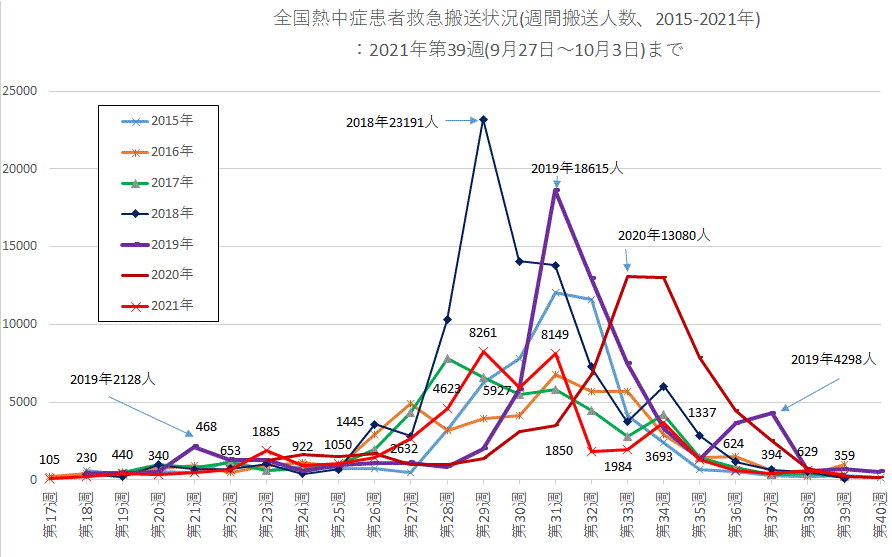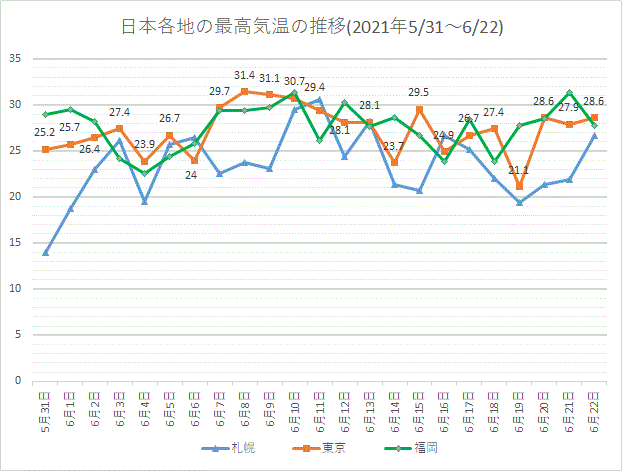- Yokohama-shi Top Page
- Health, Medical and Welfare
- Health and Medical Care
- institute for health
- Health Information
- The topic of health
- Heat stroke information
- Emergency transport of heat stroke patients nationwide (2021)
Here's the text.
Emergency transport of heat stroke patients nationwide (2021)
Last Updated October 24, 2024
Emergency transport of patients with heat stroke nationwide: Until the 39th week of 2021 (September 27-October 3)
Heat stroke often occurs in hot summers, and the Fire and Disaster Management Agency of the Ministry of Internal Affairs and Communications summarizes the emergency transport status of heat stroke patients from May to September in Japan every year. However, in fiscal 2020 (Reiwa 2), May was not included in the survey period due to the impact of COVID-19, but the survey period was short from Monday, June 1. In 2021 (Reiwa 3), the survey was returned to the usual year, and the survey was started on Monday, April 26. The graph below shows the number of weekly transporters in the emergency transport status of heat stroke patients nationwide since 2015. Every year, after the rainy season, the number of emergency transporters of heat stroke patients increases rapidly. Looking at the relationship between the end of the rainy season in the Kanto Koshin region and the peak week of the number of emergency transports for heat stroke patients nationwide, the 28th and 31st week in 2015, the 30th and 31st week in 2016, the 27th and 28th week in 2018, the 26th week and 29th week 29th week 3rd week 29th week 29th week 19th week 19th week and 19th week, and 10th week, and 1st week 10th week 1st week 2nd week, and 10th week 10th week and 10th week 10th week 1st week 2nd week, and 10th week As in 2016, 2017, and 2019, the week following the end of the rainy season in the Kanto Koshin region is often the week of the peak of the number of emergency transports for heat stroke patients nationwide.
In addition, according to a summary of the Fire and Disaster Management Agency of the Ministry of Internal Affairs and Communications (reference: Fire and Disaster Management Agency of the Ministry of Internal Affairs and Communications "Emergency Transport Situation due to Heat Stroke in 2020" October 27, 2020), the ratio of elderly people aged 65 and over to the highest number of emergency transport locations due to heat stroke was 3. Due to the COVID-19 pandemic, many people were in their homes ahead of going out, and many elderly people were at home. From May to September, when there are many heat strokes, heat stroke measures are also important in addition to corona measures.
The number of emergency transport weeks for heat stroke patients nationwide in 2021 (Reiwa 3) is as shown in the red line in the graph below. The number of personnel is also shown in numerical values on the graph. May is rarely seen every year, but in some years, as in 2019, small peaks were seen due to the arrival of strong heat waves. Also, in 2020 (Ryowa 2), the number of emergency transport weeks for heat stroke patients was larger than usual, probably due to the effects of wearing masks in high humidity during the rainy season.

Trends in the number of emergency transport personnel for heat stroke patients nationwide (2015-2021)
In addition, the above graph is created using the figures announced by the Fire and Disaster Management Agency of the Ministry of Internal Affairs and Communications website heat stroke information "List of Past Data (From 2008) (outside site)". Regarding the number of emergency transport personnel for heat stroke patients in the week of 2021 (Reiwa 3) in the graph, we will first use the weekly report (preliminary report) and then correct it in the monthly report (confirmed value).
In addition, for more information about heat stroke, please see our Yokohama City Inst. of Health web page "Let's prevent heat stroke (heatstroke, sunstroke)" .
For 2021 (Reiwa 3), in the 23rd week (June 7-13), the number of emergency transport personnel nationwide was 1885, which was higher than usual. In the 23rd week (June 7-13) of 2021 (Reiwa 3), the temperature rose nationwide from the 22nd week (May 31-June 6), and midsummer days (maximum temperature was 30 degrees Celsius or more) and summer days (maximum temperature was 25 degrees Celsius or higher). The graph below shows trends in the highest temperature in Sapporo, Tokyo and Fukuoka. In particular, June 10 was covered by high pressure nationwide and was particularly large in midsummer days (maximum temperature is 30 degrees Celsius or higher) and summer days (maximum temperature is 25 degrees Celsius or more). The number of emergency transport personnel is 396, and throughout the 22nd, 23rd and 24th weeks (from May 31st to 6th). The maximum temperature on June 10 was 29.5 degrees Celsius in Sapporo, 29.4 degrees Celsius in Asahikawa, 30.7 degrees Celsius in Tokyo, 32.1 degrees Celsius in Osaka, and 31.3 degrees Celsius in Fukuoka. . In Yokohama City, the fine weather continued on June 8, 9, 10, and 11 for 4 days including June 10, and the maximum temperature was 30.2 degrees, 30.4 degrees, 29.3 degrees, and 28.2 degrees. The number of emergency transport personnel was also large with 7, 4, 4 and 4 people. From May 1 to June 27, the total number of emergency transport personnel for heat stroke patients in Yokohama City was 59, but during this period there were four or more emergency transport personnel for heat stroke patients. Only days.

Graph of Changes in Highest Temperatures in Sapporo, Tokyo and Fukuoka (2021)
On July 16, 2021 (Reiwa 3), the Japan Meteorological Agency announced that "Kanto Koshin, southeastern Tohoku, and northern Tohoku are likely to have passed the rainy season." Every year, the incidence of heat stroke increases rapidly after the rainy season, but in 2021, the number of emergency transport personnel for heat stroke is 4,623 in the 28th week (July 12-18) and the 29th week (July 19-25), as shown in the graph, the number of emergency transport personnel increased rapidly after the rainy season. It's the arrival of a season with a lot of heat stroke. Let's be careful about heat stroke prevention.
Reference webpage
- Fire and Disaster Management Agency of the Ministry of Internal Affairs and CommunicationsHeat stroke information (outside site)」・「List of past data (from 2008) (outside site)」
- Yokohama City Inst. of HealthHeat stroke information」
- Yokohama City Inst. of HealthEmergency transport of patients with heat stroke nationwide (2018)」
- Yokohama City Inst. of HealthEmergency transport of patients with heat stroke nationwide (2019)」
- Yokohama City Inst. of HealthEmergency transport of patients with heat stroke nationwide (2020)」
First published on June 2, 2021
Updated on October 6, 2021
Inquiries to this page
Infectious Diseases and Epidemiology Information Division, Medical Care Bureau Institute of Health
Telephone: 045-370-9237
Telephone: 045-370-9237
Fax: 045-370-8462
Email address: ir-eiken@city.yokohama.lg.jp
Page ID: 115-384-858







